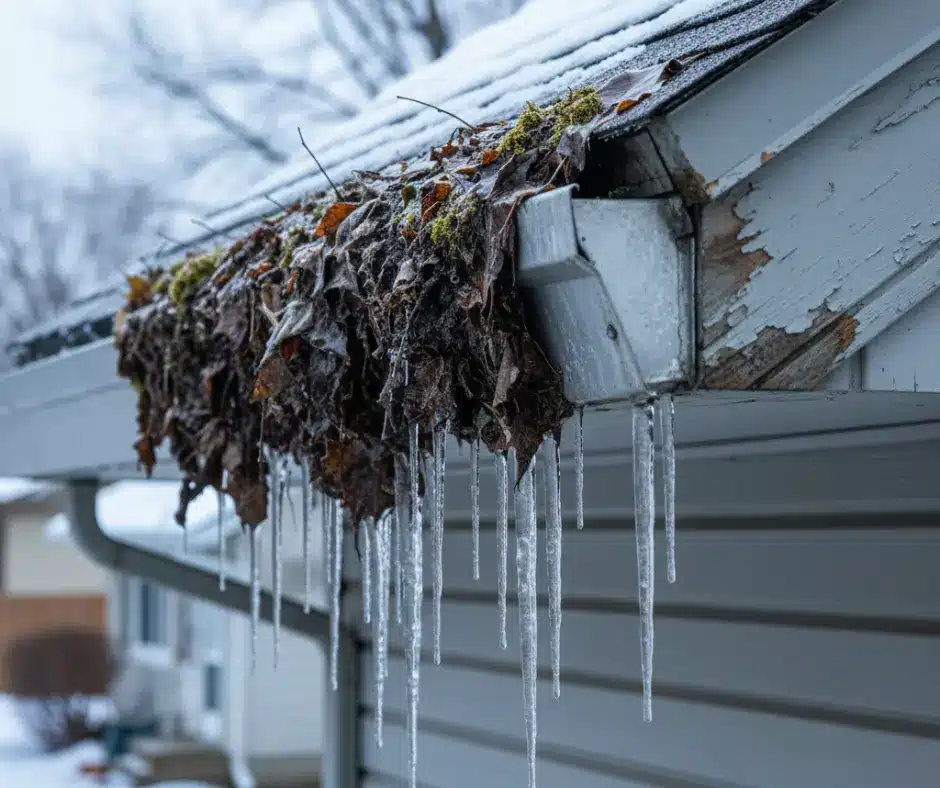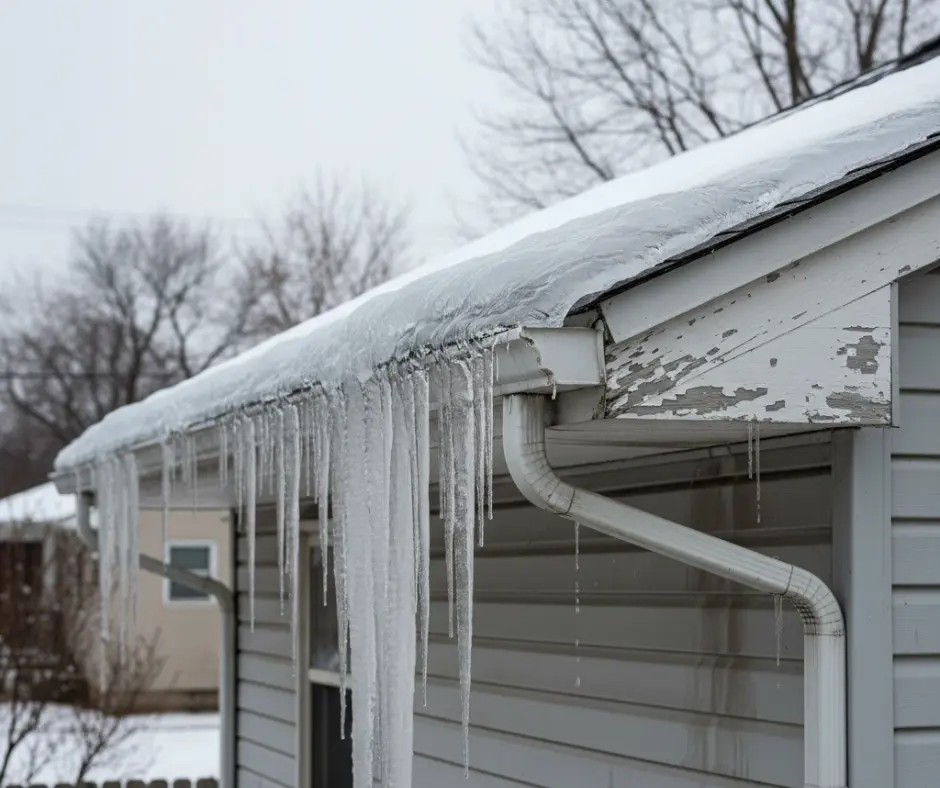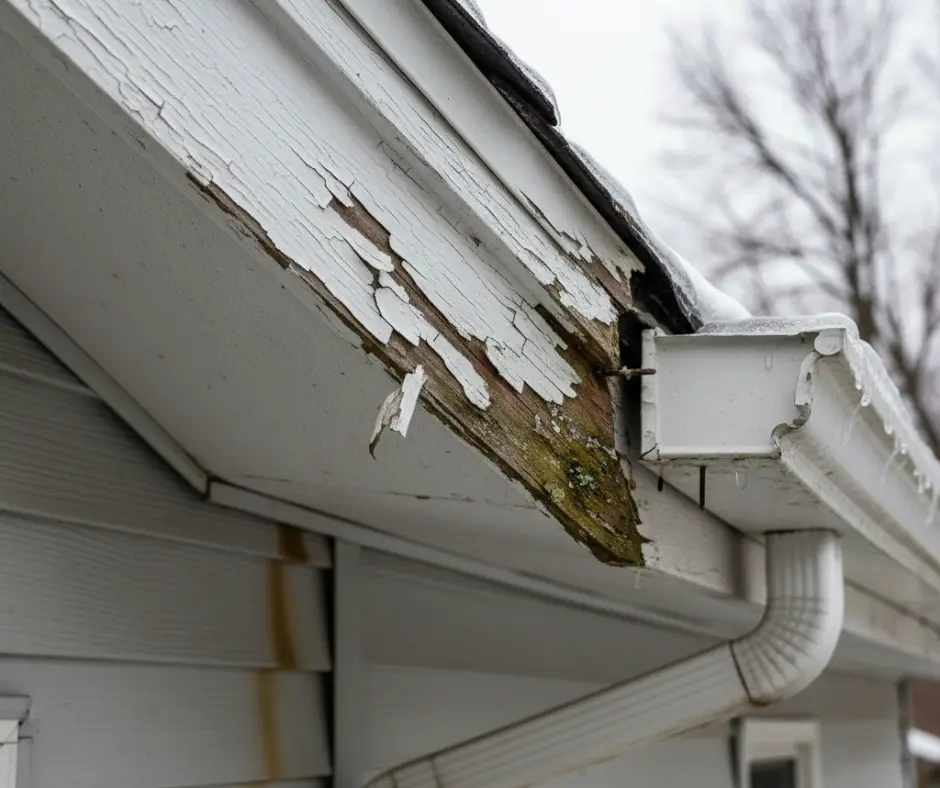Clean Gutters Now or Pay Later: How A Clogged Gutter Lead to Winter Damage

You’ve seen the leaves pile up in your gutters. You’ve told yourself you’ll deal with it later.
Here’s the problem: later costs more.
In Winnipeg, clogged gutters don’t just sit there. They turn into ice dams, rotted wood, and thousands of dollars in repairs. The leaves and debris you ignore in October become your biggest expense in February.
This isn’t about fear tactics. It’s about physics and what happens when water can’t drain properly in minus-30-degree weather.
Let’s break down exactly what goes wrong when you skip the ladder this fall.
What Happens Inside a Clogged Gutter
Your gutters exist for one reason: to move water away from your roof and foundation. When leaves, twigs, and sediment block the flow, the system fails.
Standing water collects in the channel. In September and October, this water sits there. It seeps into small cracks. It saturates the wood behind your gutters.
Then winter arrives.
That standing water freezes. Ice expands by roughly 9% when it forms. This expansion pushes against everything around it: your fascia boards, your soffit, your gutter seams.
The freeze-thaw cycle we experience in Winnipeg makes this worse. Temperatures swing from minus 20 to plus 5 within days. Water melts, seeps deeper, and freezes again. Each cycle forces more damage into your exterior materials.
How Clean Gutters Prevent Ice Dams
Ice dams form when heat escapes through your roof, melts snow at the peak, and that water refreezes at the eaves, where it’s colder.
Clean gutters before winter to give that meltwater a path to drain. When gutters flow freely, water moves off your roof before it can refreeze.
Clogged gutters create the opposite condition. Debris blocks drainage. Water backs up under your shingles. It pools at the roof edge. Then it freezes solid.
That ice creates a dam that blocks all the meltwater behind it. This water has nowhere to go except sideways, under your shingles, and into your roof deck.
A typical ice dam in Winnipeg can weigh 300 to 500 pounds per linear foot. That weight pulls on your gutters, stresses your fascia, and keeps water pressed against vulnerable areas for weeks.
The damage compounds:
- Water infiltrates through nail holes in your shingles
- Moisture soaks into the roof decking and causes rot
- Ice weight pulls gutters away from the fascia
- Continuous water exposure ruins the wood structure behind your roofline
Fascia Board Damage: The Hidden Cost
Your fascia boards are the vertical pieces of wood that run along your roof edge. Your gutters attach directly to them.
When you skip cleaning gutters, fascia boards pay the price.
Clogged gutters hold water against the fascia. Wood absorbs that moisture. In Winnipeg’s climate, wet wood freezes. Frozen water inside wood fibers causes the material to crack and split.
Fascia board damage shows up as:
- Soft, spongy wood that gives when you press it
- Visible rot or discoloration along the board face
- Gaps between the fascia and gutter where the wood has pulled away
- Paint peeling in sheets rather than small chips
- Water stains on your soffit or exterior wall
Replacing fascia boards costs between $15 and $30 per linear foot, including materials and labor. A typical single-story home has 100 to 150 linear feet of fascia. You’re looking at $1,500 to $4,500 for replacement.
That doesn’t include the cost to fix any interior damage if water made it through your walls.
Compare that to $200 to $400 for professional gutter cleaning twice a year.

The Real Damage Path: From Leaves to Structural Problems
Let’s walk through the complete damage sequence so you understand what’s at stake.
Stage 1: Debris Accumulation (September to October)
Leaves fall. They collect in your gutters. Organic matter breaks down and creates a thick sludge. This sludge blocks drainage holes and downspouts. Water can’t flow.
Stage 2: Water Retention (Late October to November)
Rain and early snow melt fill your gutters. The water can’t drain. It sits in the channel. Wood stays wet for days or weeks. Moisture begins to degrade the fascia and soffit.
Stage 3: First Freeze (November to December)
Temperatures drop below zero and stay there. Standing water freezes solid. Ice expands and pushes against gutter seams. Fascia boards freeze when saturated. Small cracks form in the wood.
Stage 4: Ice Dam Formation (December to March)
Your heated home warms the roof deck. Snow melts. Water runs down to the eaves where your clogged gutters create a dam. Ice builds up, sometimes 6 to 12 inches thick. Water backs up under shingles.
Stage 5: Interior Damage (January to April)
Water penetrates through your roof. It drips into your attic insulation. It stains ceilings. It runs down inside walls. By the time you see the damage inside, the exterior problems have existed for months.
What a Clogged Gutters Ice Dam Actually Looks Like
You’ll know you have a problem when you see these signs:
- Icicles hanging from your gutters that are thicker than your wrist
- Ice buildup is visible along your roof edge
- Water stains on your exterior walls just below the roofline
- Gutters sagging or pulling away from the house
- Ice or water inside your attic space
- Ceiling stains in rooms along exterior walls
One ice dam we removed last winter in Fort Garry measured 14 inches thick and ran 40 feet along the south-facing roof edge. The homeowner had skipped gutter cleaning for two years. The repair bill included new fascia boards, roof deck replacement in three sections, gutter reinstallation, and interior ceiling repair. Total cost: $8,700.
The gutters could have been cleaned for $300.
When to Clean Gutters Before Winter
Timing matters in Winnipeg. You have a narrow window to get this done.
Best time: Late October to early November
This catches the bulk of leaf fall from mature trees. Most deciduous trees in Winnipeg drop their leaves between mid-October and the first week of November.
Second cleaning: Late November
If you have oak trees or other late-dropping species, schedule a second cleaning after the last leaves fall. This ensures your gutters enter winter completely clear.
Don’t wait for the first snow. Once temperatures stay below zero consistently, cleaning becomes difficult. Frozen debris needs to be chipped out. Water in downspouts freezes solid and blocks the entire system.

How to Know If Your Gutters Need Cleaning
You don’t need to climb a ladder to check. Look for these indicators from the ground:
- Plants growing out of your gutters
- Visible debris or leaf piles when you look up from below
- Water spilling over the gutter edge during rain instead of flowing through the downspouts
- Stains on your siding directly below the gutter line
- Gutters that appear to sag or have separated sections
- Birds or squirrels frequenting your roofline
If you see any of these signs, your gutters need attention now.
The DIY Risk: Why Property Managers Hire Professionals
You can clean gutters yourself. Many homeowners do.
But consider the risks:
Ladder falls cause more than 500,000 injuries annually in North America. About 300 of those are fatal. Working at height in cold weather with wet leaves increases that risk.
Professional gutter cleaning costs $150 to $400, depending on your home’s size and gutter length. That service includes:
- Removal of all debris from gutters and downspouts
- Inspection of gutter attachment points
- Check for proper slope and drainage
- Identification of any damage or needed repairs
- Disposal of debris
Property managers handling multiple buildings prefer scheduled professional service because it provides documentation, ensures consistent results, and removes liability.
What Clean Gutters Actually Accomplish
When your gutters flow freely, water moves through the system and away from your home. This protects:
Your foundation: Water drains 4 to 6 feet away from your foundation walls, preventing basement seepage and foundation cracks.
Your roof deck: Proper drainage prevents water backup under shingles, protecting the plywood or OSB sheathing beneath.
Your fascia and soffit: Dry wood resists rot, insect damage, and the freeze-thaw destruction that ruins these components.
Your siding: Water that drains properly doesn’t run down your exterior walls, preventing stains, rot, and moisture infiltration.
Your landscaping: Controlled water flow through extensions prevents erosion around your home’s perimeter.
Beyond Cleaning: What Else to Check
While you’re addressing your gutters, inspect related areas:
Check your downspouts: They should extend at least 4 feet from your foundation. If they drain too close to your home, add extensions.
Inspect gutter slope: Gutters should slope 1/4 inch per 10 feet toward downspouts. If you see standing water after cleaning, your slope needs adjustment.
Look at gutter seams: Check for gaps or separation where sections connect. Seal any leaks with gutter sealant before winter.
Examine attachment points: Gutter hangers should be spaced 24 inches apart maximum. If you see sagging between hangers, add more supports.
Review your attic ventilation: Proper ventilation prevents the heat buildup that causes snow to melt and create ice dams. Your attic should be within 5 degrees of outdoor temperature.
The Cost Comparison: Prevention vs. Repair
Let’s look at real numbers from jobs we completed last year.
- Preventive gutter cleaning (twice yearly): $300 to $600 annually
- Minor fascia repair (one section): $400 to $800
- Full fascia replacement (one side of the house): $1,500 to $3,000
- Ice dam removal: $400 to $1,200 per occurrence
- Roof deck repair from ice dam damage: $2,000 to $5,000
- Interior water damage repair: $1,500 to $8,000
- Gutter replacement (entire home): $1,200 to $3,500
The pattern is clear. Regular maintenance costs a few hundred dollars. Repairs from neglect cost thousands.

What All Weather Exteriors Does Differently
We approach gutter service with the same attention we give to roof replacement. Here’s what that means:
We document conditions: Photos before and after service show exactly what we found and what we fixed.
We report problems early: If we spot fascia damage or gutter issues during cleaning, we tell you immediately with photos and a clear cost estimate for repair.
We work year-round: We clean gutters into late November, even when other companies have stopped for the season.
We handle commercial properties: Property managers need reliable service across multiple buildings. We schedule and track service for entire portfolios.
We combine services: If you need roof inspection, gutter cleaning, and fascia repair, we coordinate everything in one visit.
Your Action Plan for This Season
Here’s what you need to do before winter settles in:
- Schedule your gutter cleaning now if you haven’t done it yet. The weather window in Winnipeg closes quickly.
- Walk around your property and look up at your roofline. Take photos of anything that looks damaged or concerning.
- Check your downspouts. Make sure they drain away from your foundation.
- If you see existing ice dams or fascia damage, call for an inspection. These problems worsen quickly.
- Mark your calendar for spring. Schedule your post-winter inspection and cleaning for early April.
Clean gutters before winter, or you’ll pay for the damage after.
Clogged gutters create ice dams. Ice dams destroy fascia boards, roof decking, and eventually your interior spaces. The progression is predictable. The costs are avoidable.
You have a choice right now. Spend a few hundred dollars on prevention, or wait and spend thousands on repair.
All Weather Exteriors has been cleaning gutters and repairing winter damage across Winnipeg for years. We’ve seen what works and what fails. We know exactly what happens when homeowners and property managers postpone this simple task.
Don’t be the property owner calling us in February with water dripping through their ceiling. Be the one who made the call in October and avoided the problem completely.
Your gutters are ready for attention. The question is whether you’ll handle it now or later.
Later always costs more.

Leave a Reply
You must be logged in to post a comment.